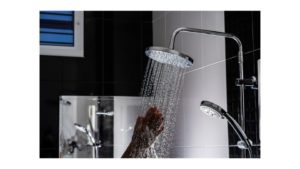It could be that you find yourself in a hotel or your friend’s house. A lot of things around the house may appear unfamiliar to you of which may include the shower.
We’ve all been in such a situation, and so you are not alone on this.
As you know, the shower has various faucet settings and knob configurations, which is why you’re in search of how to turn on the particular kind of shower that you’re currently trying to use.
In case you’re in a hurry and dying to have that refreshing rinse, here is precisely how you should turn on the different kinds of a shower:
Quick Instructions to Get Your Shower Working
Some showers will have the diverter valve fixed on top of the faucet. Hence, you’ll need to pull it upwards in order to direct the water to the showerhead after switching it on.
If not, then check beneath the faucet to see if a round diverter valve is positioned where the water gushes from. This should be pulled downward to get the showerhead running.
If the shower is a three-knob design, two knobs are used to change water temperature from hot to cold, while the third knob functions as the diverter to channel the water to flow from the showerhead.
That being said, you don’t always have to spend silly hours or call for assistance each time you are in a new room and trying to get any shower brand to work.
In the rest of this article, we have explained how you can turn on any shower diverter, as well as a step-by-step guide on how to go about the instructions given above.
By the end of this post, you should effortlessly switch from the ‘filling the tub’ position to the ‘shower’ position and know how to turn on showers without a pull tab which many find pretty challenging.
To begin with…
What you should know about shower settings
As mentioned ealier, the setting of bathroom showers is fixed with different valve designs and knob configurations as per the plumbing of the apartment.
If your shower has a single knob, it means you can adjust the temperature from hot to cold and vice versa by just swinging it to one way or the other.
Whereas there are other bathroom showers designed with two knobs that regulate cold and hot temperatures individually. These two knobs can be swung at your decretion to match the warmness level of water you want.
But in cases where it is a three-knob design, the third one functions as the diverter.
Meanwhile, showers with a single or dual knob will usually have the diverter positioned on the top of the faucet or beneath it, which you will have to pull.
There are many other shower settings out there, but the ones outlined above are the common ones.
How to turn on three-knob designed showers
Now that you can wrap your head around how these things work, turning on whatever kind of shower system you are about to use becomes more effortless.
Since it is your first time, you can’t be sure which of the three knobs will be the diverter since they are all identical.
The last thing you want is to be taken by surprise and get your skin ice burnt while checking each of them. So, do these:
Step 1: You want to make sure you’re not under the shower
Step 2: Try each of the knobs one after the other to see their function as the water runs
Step 3: Place your hand under the running water to observe the two knobs that function as temperature change
Step 4: Note the one knob that adjusts the water flow from the tap to the showerhead
Using showers and diverter positions
You now know that if the shower isn’t a three-knob design, the diverter could be placed on top or underneath the faucet as a small lever that you will need to pull to direct the water up to the showerhead.
If you can see the diverter valve positioned on the water spigot, do these:
Step 1: Use the knob above on the wall to select the water temperature you want by swinging it according to the indication as to the water flows
Step 2: Now, you want to pull the diverter upward
Step 3: You should be ready now because the pull causes the water flow to seize from the faucet and immediately gush from the showerhead above.
If there is no diverter positioned on the tap, it means it has been fixed underneath. So, do these:
Step 1: Follow steps 1above
Step 2: Now, pull the round lever located beneath the faucet – exactly the hole where the water is flowing from
Step 3: Observe the water changing direction from the faucet to the showerhead above.
What to do when your shower won’t turn on
At this point, you should be happy over how you’ve finally gotten your shower to work already.
If it doesn’t turn on still, it can only mean a problem with the valve or the spigot, which demands repair or replacement.
It is usual for these things to happen in hotels or the apartment you are settled at for your vacation.
You might eventually need to call on someone to have it fixed or detect any technical fault.
Conclusion
The last thing we all want is not being able to do timely things such as turning on the shower, especially when we’re in dire need of a rinse due to sweats and heat.
I hope you can get your shower to work by now, as this brings us to the end of this article. Feel free to share in the comments how the information here gave you headway. Enjoy the rest of your day!

As the resident shower expert at ShowerJournal.com, Wayne Lee loves to share the helpful tips and tricks he’s picked up over the years during his job as a handyman.

